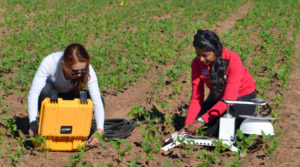Texas A&M leading organic grain crop study
Writer: Kay Ledbetter, 806-677-5608, [email protected]
Contact: Dr. Nithya Rajan, 979-845-0360, [email protected]
Dr. Muthu Bagavathiannan, 979-845-5375, [email protected]
Dr. Ronnie Schnell, 979-845-2935, [email protected]
COLLEGE STATION – Dr. Nithya Rajan and her colleagues believe organic grain and soybean crops have an enormous opportunity to satisfy demand for specialty feed for a growing niche livestock industry in Texas.

Rajan, a Texas A&M AgriLife Research crop physiologist in the soil and crop sciences department at College Station, recently received a three-year, $475,000 U.S. Department of Agriculture National Institute of Food and Agriculture grant to study organic grain and soybean cropping systems.
Joining Rajan on this project are Dr. Muthu Bagavathiannan, AgriLife Research weed scientist, and Dr. Ronnie Schnell, Texas A&M AgriLife Extension Service cropping systems specialist, all in the Texas A&M department soil and crop sciences department in College Station.
Sam Houston State University will also be involved with the economics and social survey work, she said.
“Pathway to Organic: A Research, Extension and Education Project in the Southeast U.S. on Transitioning Cropping Systems” came about after the group’s discussion with an organic feed mill owner who described difficulties sourcing organic grain to meet the demands for certified organic feed products.

Texas lags behind in organic crop production, she said, and that has become a problem for the organic livestock sector of the state that is looking for grain crops such as corn and sorghum.
“Limited information on organic farming practices is available to producers in Texas, especially for large-scale grain production,” Rajan said. “Our goal is to identify organic cropping systems and management techniques for successful production of organic grain crops in Texas.”
Rajan said they have other specific goals with this study, including a greater understanding of the influence of organic management practices on nutrient cycling, greenhouse gas emissions, weed dynamics, water-yield relations and soil health.
“One goal of the project is to determine if there is an advantage for climate change mitigation by migrating to cropping systems that utilize cover crops and conservation tillage,” she said.
Weed control and nutrient management are major concerns for organic grain producers, Bagavathiannan said.

“We aim to develop best management practices for weed suppression and nutrient management through sound integration of fall-planted cover crops such as cowpeas and cereal rye-hairy vetch mixtures,” he said. “A unique treatment is double-cover cropping with a 60-day cowpea, followed by the cereal rye-hairy vetch mixture.”
Bagavathiannan said with a long growing season after crop harvest in southern Texas, “these cover crops will help reduce seed production from pigweeds and other summer-annual weeds that emerge after crop harvest, in addition to their value in weed suppression during the main grain crop production.”
The cowpea also is the first component of an intensive cover crop system to meet nitrogen demand, he said. The team hopes these practices optimize both productivity and profitability of organic grain cropping systems, specifically corn, grain sorghum and soybeans.
The final step will be for Schnell to develop an educational and outreach program for efficient transfer of project results to the various stakeholders. He will organize training efforts on the certification process, farm plan development, environmental benefits and best management strategies.
The project will include conducting a three-year field study and a two-year demonstration in a farmer’s field.


